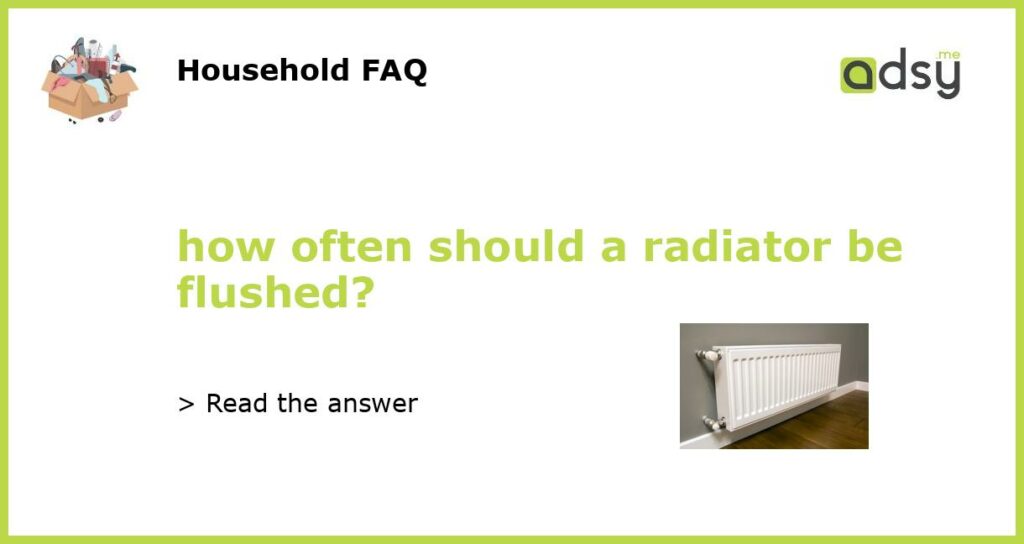How Often Should a Radiator be Flushed?
Flushing a radiator is an important maintenance task that helps keep your vehicle’s cooling system running smoothly. Over time, coolant can become contaminated with rust, corrosion, and debris, which can lead to overheating and engine damage. The frequency at which you should flush your radiator depends on several factors, including the age of your vehicle and the type of coolant used. In general, it is recommended to flush your radiator every two to five years.
Why is Radiator Flushing Important?
Radiator flushing removes old coolant from the system and replaces it with fresh coolant. This process helps maintain the proper balance of chemicals and additives in the coolant, which is essential for the radiator’s performance. Flushing also removes any accumulated debris or contaminants that can clog the small tubes and passages in the radiator, reducing its efficiency. Regular flushing helps prevent overheating, extends the life of the radiator, and keeps the cooling system functioning optimally.
Factors to Consider for Flushing Frequency
While the general recommendation is to flush your radiator every two to five years, several factors can influence how often you should flush your radiator:
1. Vehicle Age: Older vehicles tend to accumulate more debris and sediment in the cooling system, requiring more frequent flushing. If you have a classic car or an older model, consider flushing the radiator every two years.
2. Coolant Type: Different types of coolant have varying lifespan and performance. Traditional green coolants need to be flushed at shorter intervals, typically every two years. However, newer long-life coolants can last up to five years before needing a flush.
3. Driving Conditions: If you frequently drive in extreme weather conditions, towing heavy loads, or spending long hours in traffic, your engine will put more strain on the cooling system. In such cases, it is advisable to flush the radiator more frequently, perhaps every two to three years, to ensure optimal performance.
4. Coolant Contamination: If you notice signs of contamination in your coolant, such as rust particles or a milky appearance, it indicates a problem with the cooling system. In such cases, flushing the radiator and addressing the underlying issue is crucial to prevent further damage.
5. Manufacturer Recommendations: Always consult your vehicle’s owner’s manual for the manufacturer’s recommended maintenance schedule. They may have specific guidelines for flushing the radiator based on the make and model of your car. Following these recommendations ensures that you stay within warranty terms and keep your vehicle in top condition.
Signs that Your Radiator Needs Flushing
While flushing your radiator on a regular schedule is important, there are certain signs that indicate it may be time for immediate flushing:
1. Overheating: If your vehicle consistently overheats or the temperature gauge rises to the red zone, it may be a sign of a coolant-related issue. Flushing the radiator can help remove any blockages and improve the coolant’s cooling capacity.
2. Rusty Coolant: If your coolant appears rusty or discolored, it signifies the presence of rust in the system. Flushing the radiator can help remove the rust particles and prevent further corrosion.
3. Sludge Build-up: If you notice a gel-like substance or sludge in the coolant, it is a clear indication of contamination. Flushing the radiator will help remove the sludge and improve coolant flow.
4. Coolant Leak: If you find coolant puddles under your vehicle or notice a drop in coolant levels, there may be a leak in the system. Flushing the radiator can help identify and address the leak, preventing further damage to the engine.
5. Foul Odor or Steam: A strong odor or the presence of steam coming from the radiator can be signs of coolant breakdown or a leak. Flushing the radiator can help resolve these issues and prevent more significant cooling system problems.
Flushing your radiator is an essential maintenance task that helps keep your cooling system running efficiently and prevents costly engine damage. While the recommended frequency for flushing is every two to five years, it is crucial to consider various factors such as vehicle age, coolant type, driving conditions, contamination, and manufacturer recommendations. Additionally, be alert for signs like overheating, rusty coolant, sludge build-up, coolant leaks, foul odor, or steam, as these may indicate the need for immediate flushing. By staying proactive with radiator maintenance, you can ensure optimal cooling system performance and prolong the life of your vehicle.






